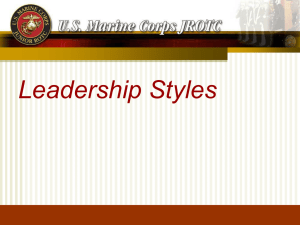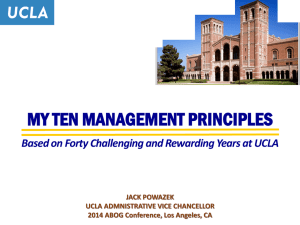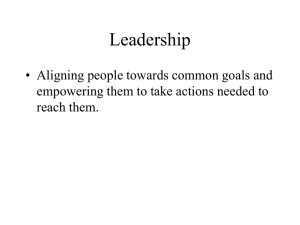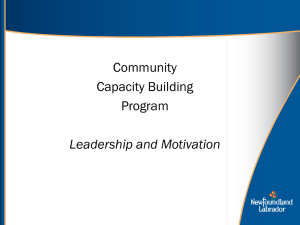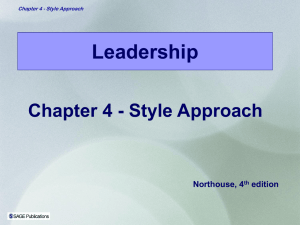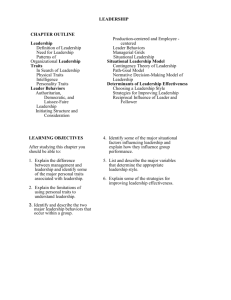Motivation in Multinational Companies
advertisement
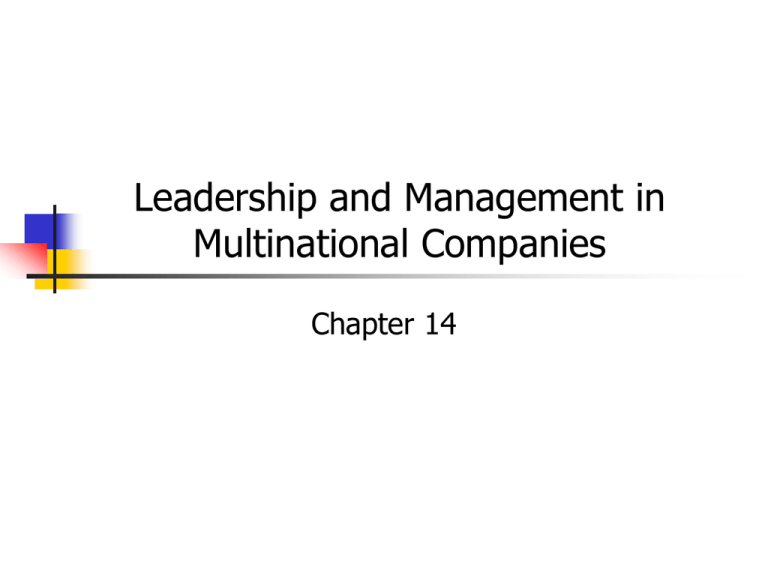
Leadership and Management in Multinational Companies Chapter 14 Presentation Outline What is leadership? Global leadership Models of leadership Leadership traits Leadership behaviors: U. S. and Japanese views Contingency theories of leadership The path-goal model National context model of leadership Presentation Outline (2) Leadership in a global context Styles of international leadership (GLOBE study) National context and subordinates' expectations Effects of power distance Transactional and transformational leadership Effective leadership behaviors Attribution and leadership Should you do what works at home? Leadership Leadership: process of influencing group members to achieve organizational goals Excellent leaders Motivate their employees to achieve more than minimal requirements What makes a great leader? Many formal theories of leadership exist Most people have their own beliefs Global Leadership: The New Breed One who has the skills and abilities to interact with and manage people from diverse cultural backgrounds Characteristics of a global leader Cosmopolitan Skilled at intercultural communication Culturally sensitive Capable of rapid acculturation Global Leadership: Characteristics Knowledgeable about cultural and institutional influences on management Facilitator of subordinates’ intercultural performance A user of cultural synergy A promoter and user of the growing world culture A commitment to continuous improvement in self-awareness and renewal Three Classic Models: A Vocabulary of Leadership Three basic models of leadership Leadership traits Leadership behavior Contingency leadership Leadership Traits Are leaders born or made? Great-person theory: idea that leaders are born with unique characteristics that make them quite different from ordinary people Contemporary views of leadership traits do not assume that leaders are born Traits of Successful U.S. Leaders Higher intelligence and self-confidence More initiative More assertiveness and persistence Greater desire for responsibility and the opportunity to influence others A greater awareness of the needs of others Leadership Behaviors U.S. perspectives on leadership behaviors Two major types of leadership behaviors Task-centered leader: focus on completing tasks by initiating structure Gives subordinates specific standards, schedules, and tasks Person-centered leader: focus on meeting the social and emotional needs of employees Leader Decision Making Styles Autocratic leadership: leaders make all major decisions themselves Democratic leadership: leader includes subordinates in decision making Consultative or participative leadership: leader’s style falls midway between autocratic and democratic styles Exhibit 14.1: Likert’s Four Styles of Management Japanese Perspectives on Leader Behaviors Performance-maintenance (PM) theory: balancing task- and person-centered leader behaviors Performance-Maintenance Theory Two dimensions of PM theory Performance function (P): similar to task-centered leadership Two components of performance function Planning component: the leader works for or with subordinates to develop work procedures Pressure component: the leader then pressures employees to put forth more effort and to do good work Performance-Maintenance Theory Maintenance function (M): similar to personcentered Presents behaviors that promote group stability and social interaction Difference between the Japanese PM approach and the U.S. perspective Japanese PM leader focuses on influencing groups U.S. approach focuses on influencing individuals Path-Goal Theory A contingency theory of leadership Four leadership styles that a manager might choose depending on the situation Directive: give subordinates specific goals, structures, schedules Supportive: show a concern for satisfying subordinates' needs and establish good relationships Participative: consult with subordinates, take suggestions, encourage participation in decision making Achievement-oriented: set goals and reward goal accomplishments Exhibit 14.3: A Simplified Model of Path-Goal Theory Path-Goal Theory: Key Suggestions When subordinates have high achievement needs, use the achievement-oriented style When subordinates have high social needs, use the supportive leadership style When job is unstructured, use a directive style or an achievement-oriented style National Context as a Contingency for Leadership Behaviors Successful leadership in multinational companies requires that managers adjust their leadership styles to fit different situations. National Context as a Contingency for Leadership Behaviors Two steps to adjust a leadership to a multination Step 1: understanding what local managers do to lead successfully in their own country Step 2: using this knowledge to modify your leadership style National-context contingency model of leadership: shows how culture and related social institutions affect leadership practices Exhibit 14.5: National-Context Contingency Model of Leadership The National-Context Contingency Model of Leadership Outlines of how leadership behaviors, traits, and contingencies are affected by the national context: Leader behaviors and traits Subordinates’ characteristics Work setting Leadership Traits and Behaviors in the National Context GLOBE (Global Leadership and Organizational Behavior Effectiveness) The very latest research on cross-national differences in leadership Study contains insights regarding crucial leadership styles to navigate successfully through a maze of cultural settings Exhibit 14.6 Culture Free Positively and Negatively Regarded Leadership Traits and Behaviors from 60 countries Exhibit 14.7: GLOBE’s Study Clusters and Countries Included in Each Cluster Styles of International Leadership (GLOBE study) Charismatic/Value-Based leadership captures the ability of leaders to inspire, motivate, and encourage high performance outcomes from others based on a foundation of core values. Team-Oriented leadership places emphasis on effective team building and implementation of a common goal among team members Styles of International Leadership (2) Participative leadership reflects the extent to which leaders involve others in decisions and their implementation. Humane-oriented leadership comprises supportive and considerate leadership. Autonomous leadership refers to independent and individualistic leadership behaviors. Self-protective leadership “focuses on ensuring the safety and security of the individual and group through status-enhancement and face-saving.” GLOBE findings Team-oriented leaders are preferred in Latin European and Southern Asian countries. Anglo and Germanic cultures prefer participative leaders. South Asian cultures prefer humane leaders. East Asia: Charismatic/values-based and teamoriented leadership are valued most highly (Japan, Korea) Self-protective and autonomous leaders are generally seen as ineffective National Context and Subordinates’ Expectations Subordinates’ expectations: expectations regarding what leaders “should” do and what they may or may not do High power-distance – autocratic leadership E.g., many of the Latin and Asian countries Low power-distance – the leader be more like them E.g., Sweden and Norway Comments on Exhibit 14.10 Great Britain ranks low in power distance. In 1980, the U.S. was near the middle of the power distance scale. Exhibit 14.10 is based on 1980 data for specific countries. Later studies suggest that the U. S. is now moderately low in power distance. Mexico is a high power distance country. Exhibit 14.10 still provides useful information about how power distance affects employee expectations. Exhibit 14.10: Subordinates’ Expectations under Three Levels of Power Distance Transactional and Transformational Leaders Transactional leadership: managers use rewards or punishments to influence their subordinates Most ordinary leaders use transactional leadership Requires adjustments in different countries Transformational Leadership Managers go beyond transactional leadership by Articulating a vision Breaking from the status quo Providing goals and a plan Giving meaning or a purpose to goals Taking risks Being motivated to lead Building a power base Demonstrating high ethical and moral standards Transformational Leaders Succeed because subordinates respond to them with high levels of performance, devotion and willingness to sacrifice Same leadership traits may not lead to transformational leadership in all countries The best leaders use both transactional and transformational leadership Exhibit 14.11: GLOBE Study and Charismatic Leadership Another Description of Transformational Leaders Idealized influence – charisma. Ability to get their followers to accept a common purpose or vision Inspirational motivation – an easy-to-understand sense of purpose regarding what should be done. Intellectual stimulation – giving people a new paradigm or world view (similar to breaking from the status quo) Individualized consideration – identify development needs and see that they are met. Leadership Behaviors in Decreasing Order of Effectiveness Transformational leaders Transactional leaders Management by exception – active – looks for problems and sees that they are resolved Management by exception – passive – deals with problems when they are called to his/her attention Laissez-faire (managers who do very little) Attribution and Leadership Emphasis on what leaders believe causes subordinates’ behaviors A key distinction in attribution External attribution: factors outside the person and beyond the person’s control (e.g., natural disasters, illness, faulty equipment, etc.) The leader corrects the work situation if possible. Internal attribution: characteristics of the person (e.g., personality, motivation, low ability, etc.) The leader rewards or punishes the person. Attribution and Leadership Fundamental attribution error: assumption by managers that people behave in certain ways because of internal motivations, rather than outside factors Common error for Western managers to make in other countries Successful leaders make the correct attributions. Getting Results: Should You Do What Works at Home? Cannot assume that successful home leadership styles or traits will result in equally successful leadership in a foreign country It is difficult to adapt. Cross-cultural training is important.

